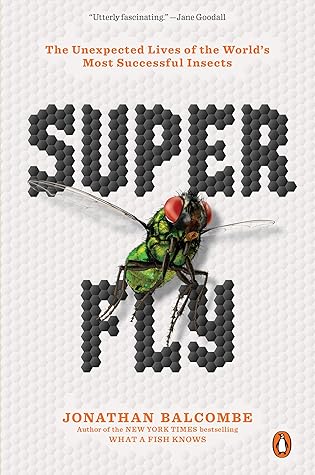Kindle Notes & Highlights
Read between
October 11 - November 10, 2022
Today, 85 percent of malaria cases occur in sub-Saharan Africa, 8 percent in Southeast Asia, 5 percent in the Eastern Mediterranean, 1 percent in the Western Pacific, and 0.5 percent in the Americas.
yellow fever afflicted more those countries that engaged in the slave trade than those that didn’t.
Bill Gates, for one, has put a ton of money into Wolbachia research.”
Gene drives work by generating a superheritable gene that can quickly spread through the affected population.
Gene drive systems could also directly reverse evolved insecticide resistance, giving once-effective compounds a new lease on life.
What if we could, for example, manipulate a fly’s olfactory system so that it was no longer attracted to the target crop?
Indeed, theoretical models have shown that even the entry of a few individuals with genedrive constructs can lead to a complete invasion of a population. It is easy to imagine that gene drives could be a game-changer
in the control of vector-borne diseases, and why they have sometimes been called extinction drives.
Dengue is the most important reemerging insect-vectored viral disease in the tropics and subtropics.
we need to recognize that pest in this context is an anthropocentric term based on context and human values.
We use “pest” like we use “weed,” to designate something strictly in human terms, without regard for its ecological value beyond us.
Only about 1 percent of insect species are considered to be of any negative economic importance,
Depending on what source you consult, between 15 and 50 percent of all food grown for human consumption is lost to damage caused by insects.
Any significant pest species must be abundant, and one avenue to hyperabundance in an insect population is to provide it with large swaths of land dedicated to growing its favorite food, and a dearth of natural predators or parasites.
The most significant fly crop pests are fruit flies.
integrated pest management (IPM).
In tests, tea tree oil, andiroba oil, and citronella have each caused 100 percent mortality to houseflies and/or horn flies, and an application of hemp oil to organic crops proved highly toxic to houseflies and aphids.
swede (rutabaga)
Asian farmers have been keeping fruit flies at bay for 70 years or more using the simple, if rather labor intensive, technique of bagging the fruit in situ. Yields of such crops as mangoes, melons, and cucumbers rose between 40 and 58 percent using this technique.
In contrast, ivermectin, a drug administered orally to livestock to rid them of internal parasites, such as botflies, does not break down completely in the bovine gut. Excreted in manure, ivermectin residues can persist for 20 years or more, rendering the dung a killing field for beetles, flies, and other beneficial dung fauna.
fly storms.
Two hundred thousand stable flies emerge from an average-size winter hay feeding site, and their collective blood feeding efforts reduce annual cattle milk production and weight gain for a total estimated cost to US cattle industries of $2.2 billion per year.
As Gregory Paulson and Eric Eaton point out in their 2018 book Insects Did It First, we sprayed the boll weevil into submission, only to have the tobacco budworm take its place.
Xerces Society,
As long as the human footprint on Earth continues to expand, we should not expect the fly footprint on humans to contract.
removal of keystone species results in large-scale changes to the stability of an entire ecosystem.
God in His wisdom made the fly And then forgot to tell us why. —OGDEN NASH
The two most important of these for forensic entomology are the blowflies and the flesh flies
Cluster flies, for instance, are parasitoids of earthworms.
Buck Ruxton.
Isabel LeBourdais,
scuttle flies
Pekka Nuorteva, formerly with the University of Helsinki,
flesh fly larvae develop faster on the tissue of corpses containing cocaine and methamphetamine
Heroin also speeds up larval growth but retards development during the pupal stage.
molecular analysis of maggots recovered at a crime scene can yield the identity of a body that is no longer present.
There are reports of the successful use of maggots for wound healing by Mayan Indians and by aboriginal tribes in Australia.
Gangrene-causing bacteria became maggot food.
Not only did maggots devour harmful bacteria, but they converted their food into an additional benefit; substances excreted by the maggots were later found to accelerate healing and prevent the need for many amputations.
At that time, the death rate for compound fractures of the femur was about 75 to 80 percent.
By the mid-1940s, the antibiotics revolution was under way. These wonder drugs not only cleared up the sorts of intractable lesions that until then only maggots had successfully treated, but they also prevented wounds from becoming infected in the first place. Despite occasional cases of successful maggot-assisted wound healing, the insects fell out of favor.
As agile microbes developed resistance to the drugs developed to suppress them, agile physicians sought alternatives, and maggots began a resurgence.
its acceptance in 2004 as a US Food and Drug Administration–approved method.
The maggots do two types of debridement: mechanical and enzymatic.
maggots’ digestive enzymes, which liquefy infected and dead tissue into a nutrient-rich brew
Each maggot can remove 25 grams of dead or infected tissue every 24 hours. That converts to a pound of removal a day for every 18 maggots.
they secrete allantoin, a compound with antiseptic properties that accelerate the breakdown of dead tissu...
This highlight has been truncated due to consecutive passage length restrictions.
Greenbottle fly maggots also release ammonia, which is associated with zealous cleaning by humans, and thus the horrible odor of decaying fle...
This highlight has been truncated due to consecutive passage length restrictions.
Flies’ sensitivity to stimuli normally not perceived as painful, known as allodynia, mirrors that of humans and other vertebrates suffering constant pain.
Gandhi put it succinctly: “The only way to live is to let others live.”


